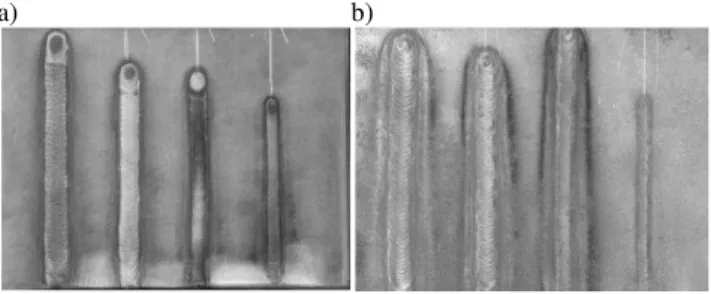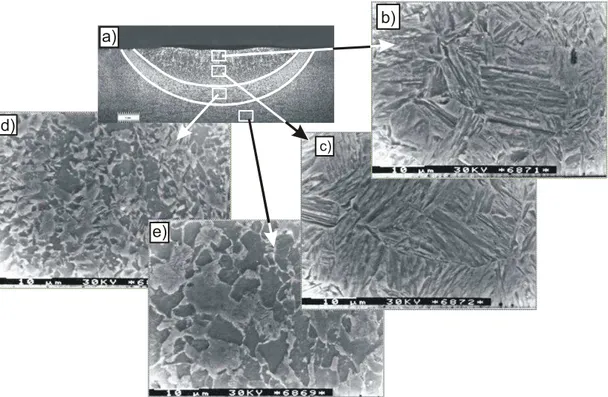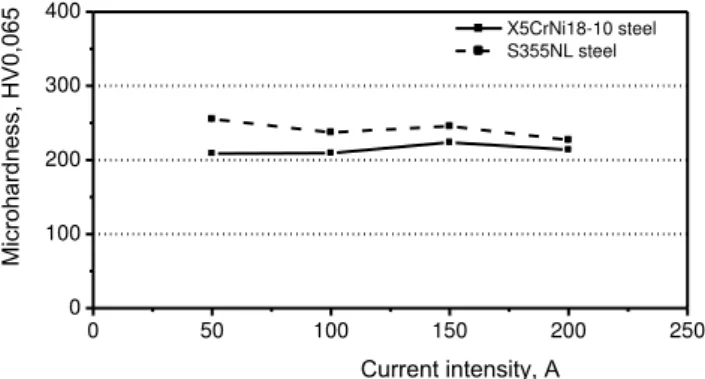A R C H I V E S
o f
F O U N D R Y E N G I N E E R I N G
Published quarterly as the organ of the Foundry Commission of the Polish Academy of Sciences
ISSN (1897-3310) Volume 12 Issue 2/2012
139 – 142
27/2
A R C H I V E S o f F O U N D R Y E N G I N E E R I N G V o l u m e 1 2 , I s s u e 2 / 2 0 1 2 , 1 3 9 - 1 4 2 139
Structure of X5CrNi18-10 and S355NL
Steels after Remelting with the Electric Arc
S. Adamiak*
Technical Institute, University of Rzeszow, Rejtana 16a, 35-111 Rzeszow, Poland *Corresponding author. E-mail address: sadamiak @univ.rzeszow.pl
Received 22-05-2012; accepted in revised form 22-05-2012
Abstract
The work presents the results of the research and tests of the surface machining of the S355NL and X5CrNi18-10 steels with the concentraded stream of heat with the usage of the GTAW method. The surface layers of the tested steels were remelted with the electric arc using the current of the electric arc 50, 100, 150 and 200A.The machining was done in the atmosphere of argon with the constant speed of the welding head. A microscope examination was performed of the obtained structure and measurements of depth, width and hardness of the received surface layer were performed. Moreover the relation between the current of the electric arc and geometry of the remelted layers with their microhardeness was examined.
Keywords: Construction Steel, Remelting of the Surface Layer, Plasma of the Electric Arc, Structure Research
1. Introduction
The tested steels have wide application as a construction material, meeting particular conditions of loading during exploitation. Steel S355NL is often used in building constructions and machine construction, operating, among others areas in mining, drilling and motor industry. Steel X5CrNi18-10 according to the standard PN-EN 10088, is ranked as resistant to corrosion. It is used in many industrial branches such as in food and chemical industry, in devices used in medicine or households. The type is widely used due to its chemical capacity in contact with many types of chemical compounds.
During the structure modification of the surface layer of the steel with the concentrated energy stream, it is important to define the influence of that machining on changes made in structure, especially during the basic crystallization. The changes of the following characteristics are also important: hardness, strength, resistance to the abrassion and plasticity of the material [1-8].
The aim of that work is to define the influence of the current of the electric arc during remelting of the steel S355NL and
X5CrNi18-10 on geometry of the remelting, changes in the material structure and the impact on hardness.
2. Methodology and materials used
for the study
The steels tested ware construction S355NL and austenitic
A R C H I V E S o f F O U N D R Y E N G I N E E R I N G V o l u m e 1 2 , I s s u e 2 / 2 0 1 2 , 1 3 9 - 1 4 2 140
a) b)
Fig. 1. Steel after remelting with different the current of the electric arc a) X5CrNi18-10, b) S355NL
Microscopic examinations of resulting structure, as well as measurements of the hardness of remelted layers, were performed in the study. The relationship between electric arc current intensity and the microstructure and microhardness was derived.
Metallography was conducted on a Neophot-2 optical microscope equipped with the system of the views analysis Multiscan and theTesla BS-340 scanning electron microscope. Microhardness measurements were done using micro-sections, perpendicular to the worked surface, with the Hanneman mph 100 microhardness tester.
3. Results description
Remelting of the surface layer with the electric arc leads to structure changes and improvement of the mechanical characteristics of the tested steels. The structure created during the crystalisation and remelted metal lake are conditioned by chemical composition of the machined material, speed gradient of the heat carrying from the remelted layer and the heat processes
done on the border remelted material – substrate material.
The influence of the strength of the electric arc on the depth and width of the remelted zone in the tested steels were presented in the table 1 and 2. The data presented are the average value from measurements carried out on the cross-sections done in five different places of the remelted paths.
Table 1.
Measurement results the depth and width of the remelted in S355NL steel
Current intensity of the electric arc
I [A]
Depth of the remelted
H in [mm]
Width of remelted
L in [mm]
50 0.90 4.16
100 1.61 6.90
150 1.83 7.61
200 2.22 8.73
The increase of current intensity of electric arc causes increase in the depth remelted from 0.90 mm at I=50A to 2.22 mm at I= 200A in steel S355NL. The width of remelted changes from 4.16 mm to 8.73 mm. In steel X5CrNi18-10 the remelted depth
changes from 0.55 mm to 1.85 mm, and the width from 3.90 mm to 8.35 mm. The amount of the remelted zone in X5CrNi18-10 steel was smaller than in S355NL steel (Fig. 2).
Table 2.
Measurement results the depth and width of the remelted in X5CrNi18-10 steel
Current intensity of the electric arc
I [A]
Depth of the remelted
H in [mm]
Width of remelted
L in [mm]
50 0.55 3.90
100 1.40 4.85
150 1.55 7.05
200 1.85 8.35
Fig. 2. Influence of the electric arc on the depth and width of remelted zone of the S355NL and X5CrNi18-10 steel
During the quick crystallization of the remelted metal in tested steels dendritic cells ware created. The cell structure in S355NL steel was consituted by the lamellar martensite. The average amount of the martensit sets was about 10 m (Fig. 3b,c). In the zone of heat influence the martensite and residual austenite were present in the structure. In the areas which were heated to
the temperature within the range Ac1-Ac3 the martensite and ferrite
were present (Fig. 3d).
In samples made from X5CrNi18-10 steel with the austenite structure (Fig. 4), the remelted zone is built from the saturated solution Fe crystallizing in the form of the dendritic cells. The direction of the main axes of crystallization was running from the remelted area to the substrate material (Fig. 4c).
50 100 150 200
0,6 1,2 1,8 2,4 D ep th, m m
Current intensity, A
50 100 150 200
A R C H I V E S o f F O U N D R Y E N G I N E E R I N G V o l u m e 1 2 , I s s u e 2 / 2 0 1 2 , 1 3 9 - 1 4 2 141 Fig. 3. The microstructure of S355NL steel after remelting with the electric arc: a) heat influence zones on the material, b, c,) the remelted
zone - structure: lamellar martensite, d) heat influence zone – structure: martensite ferrite, e) substrate material - structure: pearlite, ferrite
Fig. 4. The microstructure of X5CrNi18-10 steel after remelting with the electric arc: a) heat influence zones on the material, b, c,) remelted zone, d) heat influence zone, e) substrate material - structure: austenite
b)
d)
c)
e)
a)
b)
d)
c)
A R C H I V E S o f F O U N D R Y E N G I N E E R I N G V o l u m e 1 2 , I s s u e 2 / 2 0 1 2 , 1 3 9 - 1 4 2 142
The structural changes during crystallization and further cooling to the room temperature influenced the hardness of the surface layer. The measurements of the microhardness were done on samples made on the perpendicular plane towards the remelted
surface. The microhardness X5CrNi18-10 steel was
206 HV0.065. After turning with the electric arc, the microhardness of the remelted zone was from 197 HV0.065 (at I=50 A) to 224 HV0.065 (at I=200A). In steel S355NL of the
microhardness 184 HV0.065 after remelting with electric arc –
structure microhardness in the remelted zone was from 352
HV0.065 (at I=200A) to 400 HV0.065 (at I=50A). The
microhardness changes of the structure within the remelted zone, in the function of the intensity current of the electric arc were presented in the Fig. 5.The microhardness of the heat influence zone of the tested steels were presented in Fig. 6. No changes of microhardness were observed in relation to the intensity current of the electric arc.
Fig. 5. The average microhardness of the remelted zone of the tested steels in the function of the current of the electric arc
Fig. 6. The average microhardness of the heat influenced zone of the tested steels in the function of the current of the electric arc
4. Conclusions and statements
Parameters of the done machining provided the remelted of the surface layer of the material in all tested samples, and at the same time caused the rising of the zone construction of the complex surface layer made of remelted zone, heat influence zone
and material zone heated below the temperature Ac1.
The increase of intensity of the electric arc current from 50 A to 200 A with the scanning speed 200 mm/min caused an increase of the remelted depth from 0.85 to 3.6 mm. The width of remelted is changing from 2.9 mm to 11.3 mm with the change of current from 50 A to 300 A.
The in remelted area epitaxial increase of solid phase begins on the border of liquid-solid body and runs in accordance with the direction of moving heat source. As a result of fast crystallization in the remelting zone the dendritic cells are formed. The structure of cells in S355NL stel was composed of lamellar martensite packs. In steel X5CrNi18-10 crystals of saturated solution Fe
After remelting with the electric arc in the X5CrNi18-10 steel there were no essential microhardness improvements observed. Only with the current of the electric arc 150 A and 200 A the microhardness increased about 10% in relationship to the output material. In the construction steel S355NL the biggest microhardness was received in the structure remelted with the current of electric arc 50A and was 400 HV0.065.
Literature
[1] Correa E.O., Costa S.C., Santos J.N. (2009). Studies on
weldability of iron-based powder metal alloys using pulsed
gas tungsten arc welding process. Journal of Materials
Processing Technology. 209, 3937-3942.
[2] Orłowicz A.W., Trytek A. (2002). Effect of rapid
solidification on sliding wear of iron castings. Wear 9258.
[3] Bochnowski W. (2010). The influence of the arc plasma
treatment on the structure and microhardness C120U carbon
tool steel. Archives of Foundry Engineering. 10(1).
[4] Dziedzic A. (2010). The influence of tempering on the
microstructure and microhardeness of HS 6-5-2 steel in the area of overlapping remelting obtained with the use of the
GTAW method. Archives of Foundry Engineering. 10(1).
[5] Mróz M., Orłowicz A., Tupaj M. (2005). Thermal
coefficients of the GTAW method. Archives of Foundry. 17,
217-224 (in Polish).
[6] Sierra G., Peyre P., Deschaux Beaume F., Stuart D., Fras G.
(2008). Galvanised steel to aluminium joining by laser and
GTAW processes. Materials characterization. 59, s.
1705-1715.
[7] Lachowicz M., Nosko W. (2010). Welding of structural steel
Weldox 700. Welding Technology Review. 1/2010.
0 50 100 150 200 250
0 100 200 300 400 500
X5CrNi18-10 steel S355NL steel
M
icr
ohardness
, HV0,065
Current intensity, A
0 50 100 150 200 250
0 100 200 300 400
X5CrNi18-10 steel S355NL steel
M
icr
ohardness
, HV0,065


